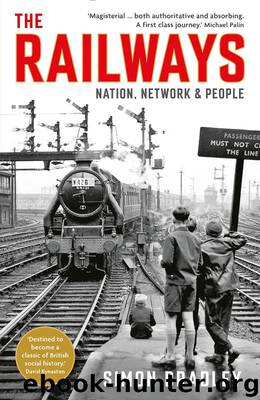The Railways by Simon Bradley

Author:Simon Bradley [Bradley, Simon]
Language: eng
Format: epub
Publisher: Profile
Published: 0101-01-01T00:00:00+00:00
Ten pounds was a lot: the upper limit on most lines was forty shillings.
The basic truth that railway lines were unsafe for public sauntering was manifest as early as 1830, when Huskisson was cut down and killed. Yet the temptation remained irresistible. Country people who had been walking the same unofficial ways across fields and through hedges for generations were reluctant to take the long way round because of some remote and bossy railway by-law, forty-shilling fine or no forty-shilling fine. More than this, the new railway routes often provided a tempting alternative to established public thoroughfares. Their average gradients were usually gentler than on the roads, and their courses straighter and shorter too. Trouble-free crossings of rivers and streams were thrown in for good measure and there were no bogs, quagmires or thick undergrowth to besmirch or hinder the feet.
This pedestrian invasion started early. The Stockton & Darlington Railway began running third-class carriages in 1835 with the specific intention of picking up fares from the many walkers who had forsaken the roads to use its line instead. The habit was shared by those who should have known better, like the workers, no doubt somewhat gone in drink, who were cut down by an express on the main line at Low Gill in Westmorland in 1859, on their way back from the feast to celebrate breaking ground for a new branch line towards Sedbergh. Once completed, this line was habitually invaded as a footpath too, as were other routes through rough fell country. Bridges that spanned obstacles where no road went, and the tracks leading to such bridges, might be especially trespass-prone. The mile-long iron viaduct that opened across the Solway Firth in 1869 proved irresistible to incomers from the Scottish side for an additional reason: the licensing laws there prohibited Sunday drinking. Until the viaduct was dismantled in the 1930s, pubs on the English side received useful extra trade from intrepid Scots travellers.
Anyone who has ever tried to walk along a railway line, licitly or otherwise, sober or otherwise, must decide how to use the sleepers. The standard spacing for these is rather too close for the average stride, but too far apart to tackle two in one step. The Scottish writer Moray McLaren discovered as much, on an unauthorised 1920s crossing of Rannoch Moor – ‘a limitless waste of peat and water’ – via the track of the West Highland Railway. The complaint came with its own remedy: ‘After about a mile or so one gradually begins to alter the natural length [of step] so that it fits the sleepers, and, if the line has been well laid out and the sleepers do not vary, one swings along with a very easy and regular motion.’ The trespasser learns to walk like a railwayman.
Smaller strides encounter less difficulty. The young characters of The Railway Children (1906), jumping the fence at the bottom of their field to walk the rails for the first time, find the sleepers ‘a delightful path to travel by – just far enough apart to serve as … stepping stones’.
Download
This site does not store any files on its server. We only index and link to content provided by other sites. Please contact the content providers to delete copyright contents if any and email us, we'll remove relevant links or contents immediately.
| Automotive | Engineering |
| Transportation |
Small Unmanned Fixed-wing Aircraft Design by Andrew J. Keane Andras Sobester James P. Scanlan & András Sóbester & James P. Scanlan(32763)
Navigation and Map Reading by K Andrew(5133)
Endurance: Shackleton's Incredible Voyage by Alfred Lansing(4716)
And the Band Played On by Randy Shilts(2163)
The Box by Marc Levinson(1965)
Top 10 Prague (EYEWITNESS TOP 10 TRAVEL GUIDES) by DK(1957)
Wild Ride by Adam Lashinsky(1950)
The Race for Hitler's X-Planes: Britain's 1945 Mission to Capture Secret Luftwaffe Technology by John Christopher(1837)
The One Percenter Encyclopedia by Bill Hayes(1811)
Trans-Siberian Railway by Lonely Planet(1725)
Girls Auto Clinic Glove Box Guide by Patrice Banks(1707)
Bligh by Rob Mundle(1676)
Looking for a Ship by John McPhee(1651)
Good with Words by Patrick Barry(1641)
Batavia's Graveyard by Mike Dash(1632)
TWA 800 by Jack Cashill(1625)
Fighting Hitler's Jets: The Extraordinary Story of the American Airmen Who Beat the Luftwaffe and Defeated Nazi Germany by Robert F. Dorr(1610)
Troubleshooting and Repair of Diesel Engines by Paul Dempsey(1578)
Ticket to Ride by Tom Chesshyre(1567)
